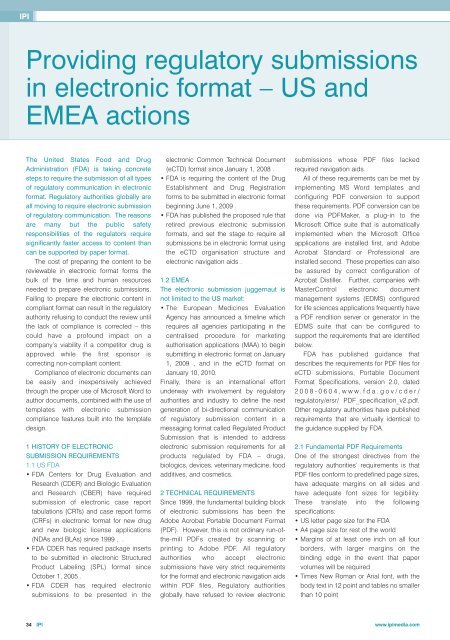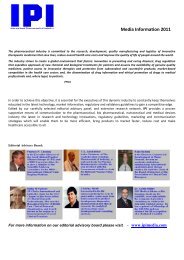IPI - Editorial
IPI - Editorial
IPI - Editorial
Create successful ePaper yourself
Turn your PDF publications into a flip-book with our unique Google optimized e-Paper software.
<strong>IPI</strong><br />
Providing regulatory submissions<br />
in electronic format – US and<br />
EMEA actions<br />
The United States Food and Drug<br />
Administration (FDA) is taking concrete<br />
steps to require the submission of all types<br />
of regulatory communication in electronic<br />
format. Regulatory authorities globally are<br />
all moving to require electronic submission<br />
of regulatory communication. The reasons<br />
are many but the public safety<br />
responsibilities of the regulators require<br />
significantly faster access to content than<br />
can be supported by paper format.<br />
The cost of preparing the content to be<br />
reviewable in electronic format forms the<br />
bulk of the time and human resources<br />
needed to prepare electronic submissions.<br />
Failing to prepare the electronic content in<br />
compliant format can result in the regulatory<br />
authority refusing to conduct the review until<br />
the lack of compliance is corrected – this<br />
could have a profound impact on a<br />
company’s viability if a competitor drug is<br />
approved while the first sponsor is<br />
correcting non-compliant content.<br />
Compliance of electronic documents can<br />
be easily and inexpensively achieved<br />
through the proper use of Microsoft Word to<br />
author documents, combined with the use of<br />
templates with electronic submission<br />
compliance features built into the template<br />
design.<br />
1 HISTORY OF ELECTRONIC<br />
SUBMISSION REQUIREMENTS<br />
1.1 US FDA<br />
• FDA Centers for Drug Evaluation and<br />
Research (CDER) and Biologic Evaluation<br />
and Research (CBER) have required<br />
submission of electronic case report<br />
tabulations (CRTs) and case report forms<br />
(CRFs) in electronic format for new drug<br />
and new biologic license applications<br />
(NDAs and BLAs) since 1999 , .<br />
• FDA CDER has required package inserts<br />
to be submitted in electronic Structured<br />
Product Labeling (SPL) format since<br />
October 1, 2005 .<br />
• FDA CDER has required electronic<br />
submissions to be presented in the<br />
electronic Common Technical Document<br />
(eCTD) format since January 1, 2008 .<br />
• FDA is requiring the content of the Drug<br />
Establishment and Drug Registration<br />
forms to be submitted in electronic format<br />
beginning June 1, 2009 .<br />
• FDA has published the proposed rule that<br />
retired previous electronic submission<br />
formats, and set the stage to require all<br />
submissions be in electronic format using<br />
the eCTD organisation structure and<br />
electronic navigation aids .<br />
1.2 EMEA<br />
The electronic submission juggernaut is<br />
not limited to the US market:<br />
• The European Medicines Evaluation<br />
Agency has announced a timeline which<br />
requires all agencies participating in the<br />
centralised procedure for marketing<br />
authorisation applications (MAA) to begin<br />
submitting in electronic format on January<br />
1, 2009 , and in the eCTD format on<br />
January 10, 2010.<br />
Finally, there is an international effort<br />
underway with involvement by regulatory<br />
authorities and industry to define the next<br />
generation of bi-directional communication<br />
of regulatory submission content in a<br />
messaging format called Regulated Product<br />
Submission that is intended to address<br />
electronic submission requirements for all<br />
products regulated by FDA – drugs,<br />
biologics, devices, veterinary medicine, food<br />
additives, and cosmetics.<br />
2 TECHNICAL REQUIREMENTS<br />
Since 1999, the fundamental building block<br />
of electronic submissions has been the<br />
Adobe Acrobat Portable Document Format<br />
(PDF). However, this is not ordinary run-ofthe-mill<br />
PDFs created by scanning or<br />
printing to Adobe PDF. All regulatory<br />
authorities who accept electronic<br />
submissions have very strict requirements<br />
for the format and electronic navigation aids<br />
within PDF files, Regulatory authorities<br />
globally have refused to review electronic<br />
submissions whose PDF files lacked<br />
required navigation aids.<br />
All of these requirements can be met by<br />
implementing MS Word templates and<br />
configuring PDF conversion to support<br />
these requirements. PDF conversion can be<br />
done via PDFMaker, a plug-in to the<br />
Microsoft Office suite that is automatically<br />
implemented when the Microsoft Office<br />
applications are installed first, and Adobe<br />
Acrobat Standard or Professional are<br />
installed second. These properties can also<br />
be assured by correct configuration of<br />
Acrobat Distiller. Further, companies with<br />
MasterControl electronic document<br />
management systems (EDMS) configured<br />
for life sciences applications frequently have<br />
a PDF rendition server or generator in the<br />
EDMS suite that can be configured to<br />
support the requirements that are identified<br />
below.<br />
FDA has published guidance that<br />
describes the requirements for PDF files for<br />
eCTD submissions, Portable Document<br />
Format Specifications, version 2.0, dated<br />
2008-0604,www.fda.gov/cder/<br />
regulatory/ersr/ PDF_specification_v2.pdf.<br />
Other regulatory authorities have published<br />
requirements that are virtually identical to<br />
the guidance supplied by FDA.<br />
2.1 Fundamental PDF Requirements<br />
One of the strongest directives from the<br />
regulatory authorities’ requirements is that<br />
PDF files conform to predefined page sizes,<br />
have adequate margins on all sides and<br />
have adequate font sizes for legibility.<br />
These translate into the following<br />
specifications:<br />
• US letter page size for the FDA<br />
• A4 page size for rest of the world<br />
• Margins of at least one inch on all four<br />
borders, with larger margins on the<br />
binding edge in the event that paper<br />
volumes will be required<br />
• Times New Roman or Arial font, with the<br />
body text in 12 point and tables no smaller<br />
than 10 point<br />
34 <strong>IPI</strong> www.ipimedia.com



